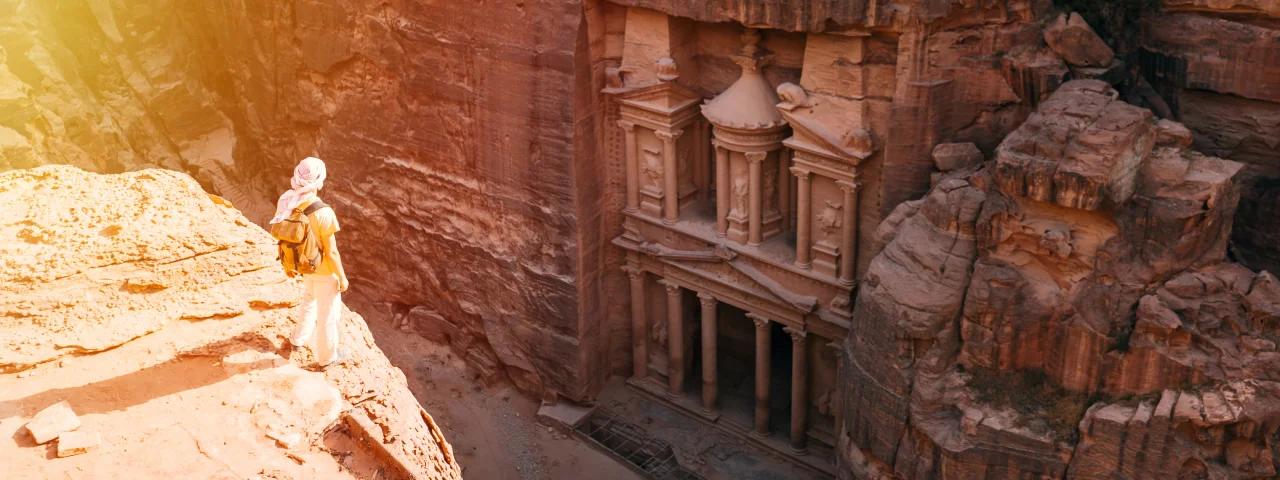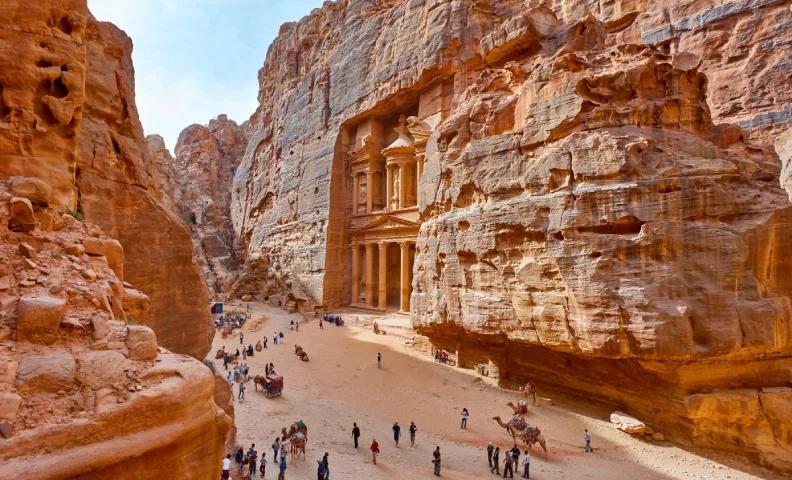
The Treasury: Exploring One of Petra's Most Iconic Landmarks
The Treasury of Petra (Al-Khazneh); what about it? Well, if you visit Petra, you'll come across the treasury of Petra (Al-Khazneh)— as you move past the Siq, the pathway becomes darker and narrower. Then all of a sudden, the Al-Khazneh treasury lights up at the end of the cleft. The Treasury (Al-Khazneh) stands magnificent as one of the most elegant monuments in the world. Let's get some quality information about this awe-inspiring monument. Al-khazneh treasury is one of the most elaborate temples in Petra, a Nabataean settlement inhabited by the Arabs in ancient times. These are the salient information you need to know about monumental sandstone rock face structures.
Who Might Have The Treasury of Petra (Al-Khazneh) Been Built For?
If you visit the Al-Khazneh treasury, you'll notice that it has so many decorated burial tombs and sites. Such a representative burial monument at a strategic and historically prominent location like this can only have been built for a Nabataean King or Queen. S.G Schmid says that before it was transformed into a monumental burial site, it was initially built as part of the first phase of the development of Petra to become an international showcase of the Nabataean Kingdom. According to Schmid, the well-to-do Nabataeams were well acquainted with Mediterranean art and architecture and knew how to make long-lasting positive impressions on visitors with elegant architectural cut-outs. These architectural models were adopted but molded into what will suit the Nabataean vision and needs.
The Iconographic Build of The Petra Temple (Al-Khazneh)
The main figure of the facade in front of the monopteros, which is the round temple with columns like a tholos, but without a cella is identified as Isis by the Basileion on the top acroterion of the pediment. The Nabataeans adopted the Isis image from Egypt, where the goddess, already worshipped in the 3rd millennium BC, was re-imagined in the Greco-Roman era and became insanely popular.
Check out our most popular Jordan Packages!
The Impact of Tourism
After the city of Petra and the treasury was forgotten in history, they came back into the limelight when it was discovered by Swiss explorer, Burckhardt in 1812. As Western Europe continued to explore the Middle East, tourism became more widespread, and by the 1920s, a small hotel was built near Petra. Though Petra was not as large as cities like Cairo, it started experiencing an influx of Europeans who visited for tourism and sightseeing. The Petran socio-economic life started to scale up, and the Bedouin people started to experience some form of an ancient civilization.
the treasury now forms a major source of tourism income in Petra and Jordan. Hotels, souvenir shops, restaurants, bars, lounges, and parks are now available in nearby cities within a few miles of Petra. Truth be told, these have improved the internally generated revenue with surges in income experience during busy tourist periods. But Petra now faces increased threats from increased tourism. The walls of Al-khazneh are getting dry and are proceeding from deposits of stearic acids due to hands resting on them. Humidity volume is increased due to large crowds of people, which is causing some of the dry sandstones to fall off. In fact, the whole surface of the treasury has received 40mm in less
than ten years from leaning, rubbing and touching on the walls by numerous visitors.

Inside the Treasury
We owe this monument to the Nabataeans. The Nabataeans built this structure when entering their ancient capital from the east in a manner far more imposing than the structure itself suggests. The open area in front of the treasury lay about 6 meters lower and was paved during this construction, and major archaeologists suggest that the pavement might have housed a pond. An open staircase which is about 13 meters in length and more than 5 meters in width crosses over older graves to a terrace in front of the portico. On the whole, this magnificent mausoleum is 25m wide and 39m high.
The facade of Al-Khazneh is abundantly decorated with floral and figurative pieces that reference the ancient Ptolemaic culture and Alexandrian architecture. It has even been suggested by reliable authorities that it was created by Alexandrian stonemasons and sculptors, and it probably took about 3 years to complete. Like most of the rock facades in Petra, it was plastered in a light layer of stucco and colorful paints.
Historians also say that possibly as early as the second half of the 1st century AD, the figurative decoration was battered by iconoclasts. As the centuries passed by, various flash floods filled the forecourt meters high with water and various debris. Notwithstanding this, the Al-Khazneh remained relatively well preserved compared to other facades in Petra. The position of the Al-Khazneh is a major factor in its preservation. The Al-Khazneh cuts deep into the vertical rock on the west face of the narrow gorge, which makes it better shielded from wind storms and rain floods. Notably, the Petra Treasury (Al-Khazneh) was probably an important pilgrimage site as there were remains of burning incense found on its premises.
Book the tickets for your customized Jordan Tour Package now!
What is Particular About The Name, "Al-Khazneh?"
The full Arabic name is "Khazneh al-Fira'un," meaning Pharaoh's Treasury comes from the local Bedouins' belief that an Egyptian Pharaoh had hidden a treasure in the urn on top of the Petra Treasury. As a result of the said treasure, the locals started shooting at this time urn again and again in the hope that gold pieces and precious stones would fall out of it— that's the main story behind the name "Petra Treasure."
Best Time To Visit The Treasury
The best time to visit is in January and February, the first two months of the year. The weather is still bearable, mildly warm, and not 50° hot like the other months.
When was the Al-Khazneh Treasury Built?
The inception of the magnificent treasury of Petra (Al-Khazneh) has been traced to the period of King Aretas IV's reign. Archaeologists and historians have come to a conclusion based on reliable findings that the massive mausoleum was probably built during the second half of King Aretas IV's reign (ruled from 9BC to 40 AD).
